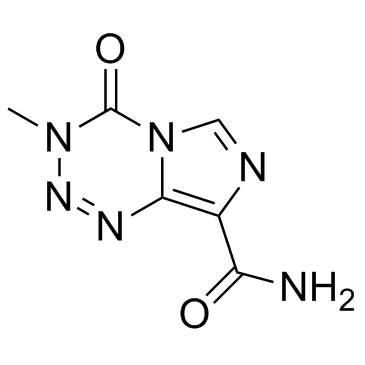Temozolomide

Temozolomide structure
|
Common Name | Temozolomide | ||
|---|---|---|---|---|
| CAS Number | 85622-93-1 | Molecular Weight | 194.151 | |
| Density | 2.0±0.1 g/cm3 | Boiling Point | 526.6±42.0 °C at 760 mmHg | |
| Molecular Formula | C6H6N6O2 | Melting Point | 212°C dec. | |
| MSDS | Chinese USA | Flash Point | 272.3±27.9 °C | |
| Symbol |


GHS07, GHS08 |
Signal Word | Danger | |
|
Combination of systemic chemotherapy with local stem cell delivered S-TRAIL in resected brain tumors.
Stem Cells 33(1) , 101-10, (2014) Despite advances in standard therapies, the survival of glioblastoma multiforme (GBM) patients has not improved. Limitations to successful translation of new therapies include poor delivery of systemic therapies and use of simplified preclinical models which ... |
|
|
Olanzapine inhibits proliferation, migration and anchorage-independent growth in human glioblastoma cell lines and enhances temozolomide's antiproliferative effect.
J. Neurooncol. 122(1) , 21-33, (2015) The poor prognosis of patients with glioblastoma fuels the search for more effective therapeutic compounds. We previously hypothesised that the neuroleptic olanzapine may enhance antineoplastic effects of temozolomide the standard chemotherapeutic agent used ... |
|
|
A new water soluble MAPK activator exerts antitumor activity in melanoma cells resistant to the BRAF inhibitor vemurafenib
Biochem. Pharmacol. 95 , 16-27, (2015) Nitrobenzoxadiazoles exert antitumor effects against vemurafenib-resistant melanoma cells by sustained activation of different MAPK pathways. |
|
|
Kinase inhibitor screening identifies CDK4 as a potential therapeutic target for melanoma.
Int. J. Oncol. 47 , 900-8, (2015) Despite recent advances in targeted therapies and immunotherapies metastatic melanoma remains only rarely curable. The objective of the present study was to identify novel therapeutic targets for metastatic melanoma. A library of 160 well-characterised and po... |
|
|
Cheminformatics analysis of assertions mined from literature that describe drug-induced liver injury in different species.
Chem. Res. Toxicol. 23 , 171-83, (2010) Drug-induced liver injury is one of the main causes of drug attrition. The ability to predict the liver effects of drug candidates from their chemical structures is critical to help guide experimental drug discovery projects toward safer medicines. In this st... |
|
|
Translating clinical findings into knowledge in drug safety evaluation--drug induced liver injury prediction system (DILIps).
J. Sci. Ind. Res. 65(10) , 808, (2006) Drug-induced liver injury (DILI) is a significant concern in drug development due to the poor concordance between preclinical and clinical findings of liver toxicity. We hypothesized that the DILI types (hepatotoxic side effects) seen in the clinic can be tra... |
|
|
A predictive ligand-based Bayesian model for human drug-induced liver injury.
Drug Metab. Dispos. 38 , 2302-8, (2010) Drug-induced liver injury (DILI) is one of the most important reasons for drug development failure at both preapproval and postapproval stages. There has been increased interest in developing predictive in vivo, in vitro, and in silico models to identify comp... |
|
|
Autophagy inhibition improves the efficacy of curcumin/temozolomide combination therapy in glioblastomas.
Cancer Lett. 358(2) , 220-31, (2015) Glioblastoma is a devastating primary brain tumor resistant to conventional therapies. In this study, we tested the efficacy of combining temozolomide with curcumin, a phytochemical known to inhibit glioblastoma growth, and investigated the mechanisms involve... |
|
|
Evaluation of a published in silico model and construction of a novel Bayesian model for predicting phospholipidosis inducing potential.
J. Chem. Inf. Model. 47 , 1196-205, (2007) The identification of phospholipidosis (PPL) during preclinical testing in animals is a recognized problem in the pharmaceutical industry. Depending on the intended indication and dosing regimen, PPL can delay or stop development of a compound in the drug dis... |
|
|
Pim1 kinase is upregulated in glioblastoma multiforme and mediates tumor cell survival.
Neuro. Oncol. 17(2) , 223-42, (2015) The current therapy for glioblastoma multiforme (GBM), the most aggressive and common primary brain tumor of adults, involves surgery and a combined radiochemotherapy that controls tumor progression only for a limited time window. Therefore, the identificatio... |